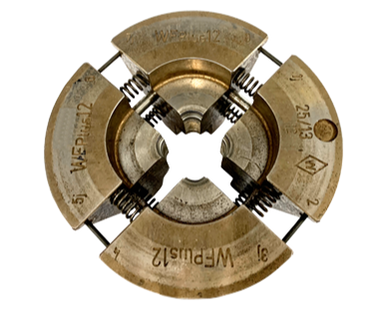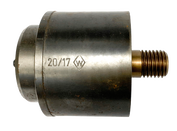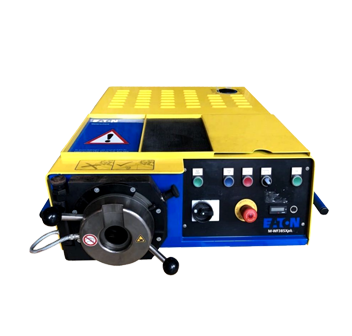|
|
|
Function |
|
Working Pressure |
|
The walform machine is a newly developed innovation that allows the assembly of tubes and compression fittings. Walform machines are produced in compliance with ATEX and it is a tube creating machine that is suitable for use in challenging prospective areas. Walform machines are applied in walform and tube fitting.
Walform machines give top-notch and quality tube connections. Walform machines help create a safe and reliable reshaping of tubes. More so, they are portable to ensure easy movement of the machine from one place to the other. The machine is divided into four different components which are DIN fitting body, DIN union nut, Viton walform seal, and mechanically reshaped tube end.
Walform machines give top-notch and quality tube connections. Walform machines help create a safe and reliable reshaping of tubes. More so, they are portable to ensure easy movement of the machine from one place to the other. The machine is divided into four different components which are DIN fitting body, DIN union nut, Viton walform seal, and mechanically reshaped tube end.
1. What is a Walform Machine?
|
The walform machine is designed in a compact and portable type form which allows users to carry along for use in different places without any stress. The installation method is the most common and frontrunner fitting for cold forming metric tube systems worldwide.
Eaton walform machine enables the forming of a profile ring in the body of the tube and this enables recognized pressure point impression while assembling the tubes. More importantly, the electrically regulated walform machine assures an efficient reshaping of tube forming alongside consistent quality and top-notch standards. The time consuming for to create a reshaped tube with walform machine is 5 to 8 seconds while conventional manual assembly method is at approximately 60 seconds. Thefore, overall with walform machine in place, it helps to save up to 50 seconds for each reshaped tube. With walform machine in forming walform tube, the overall system performance efficiency has increased whilst the risk of leakages is being reduced. |
2. What are Compression Fittings?
Compression fittings are fittings used to connect thin-walled pipes and pipes. They are often used in plumbing and electrical systems and most suitable for use for two different pipes that need to be joined. These fittings are configured to fit the sizes of the pipe ends to ensure compatibility and effective flow of fluids during operation. Compression fittings are produced in a range of sizes and made following the DIN 2553 standards.
Specifically, compression fittings are available in sizes ranging from 6mm to 42mm outer diameter and made from stainless steel and steel materials. Compression fittings are available in different configurations also and exhibit a high performance while applied in high pressure systems. Seamless tubes are majorly produced from stainless steel SS316/316L and steel ST37.4 and ST52.4.
The standard connection of tubes and fittings is done through cutting ring technology. This is a measure for DIN compliant compression fitting consisting of the nut, body, and profile ring. Cutting ring technology is a standard method used during connection and installations. The procedure involves the insertion of two cutting edges of the profile ring into the tube which births a safe and trustable sealing as the uppermost part of the profile ring tightly seals with the body of the fitting.
For experts or trained workers with previous knowledge about the installation of compression fittings, this would be an easy task, however, for more details about the compression fittings, please refer to Swagelok tube fitting assembly. This process is commonly used for repair works, environments with power failure, and low volume production. However, it comes with a potential danger due to careless human mistakes. This happens during installation, where the worker may mistakenly over tighten or over tighten the sleeves and nuts. When this happens, the system is prone to leak and it poses huge damage when the operation is under high pressure. The body sleeve is not suitable for use after installation.
Specifically, compression fittings are available in sizes ranging from 6mm to 42mm outer diameter and made from stainless steel and steel materials. Compression fittings are available in different configurations also and exhibit a high performance while applied in high pressure systems. Seamless tubes are majorly produced from stainless steel SS316/316L and steel ST37.4 and ST52.4.
The standard connection of tubes and fittings is done through cutting ring technology. This is a measure for DIN compliant compression fitting consisting of the nut, body, and profile ring. Cutting ring technology is a standard method used during connection and installations. The procedure involves the insertion of two cutting edges of the profile ring into the tube which births a safe and trustable sealing as the uppermost part of the profile ring tightly seals with the body of the fitting.
For experts or trained workers with previous knowledge about the installation of compression fittings, this would be an easy task, however, for more details about the compression fittings, please refer to Swagelok tube fitting assembly. This process is commonly used for repair works, environments with power failure, and low volume production. However, it comes with a potential danger due to careless human mistakes. This happens during installation, where the worker may mistakenly over tighten or over tighten the sleeves and nuts. When this happens, the system is prone to leak and it poses huge damage when the operation is under high pressure. The body sleeve is not suitable for use after installation.
|
The characteristics of standard assembly are enumerated below:
|
Also, the advantages of the standard assembly are as follows:
|
3. How is Compression Fittings connected to the Walform Machine?
The walform machine comprises 4 types of parts. They are shown in the table below:
|
The mechanically reshaped tube end is attached via a standard DIN fitting union nut and body whilst the sleeve has been detached. A leakage allowance may be created, however, it is blocked by using a Viton walform or elastomer ring with an addition of a metal-to-metal backup seal to give extra protection against leakages. More so, the reshaped tube eradicates any leakage allowance unlike that of the standard cutting ring system. It also reduces the probability of tube withdrawal during operation under high pressure and impulse application.
Enumerated below are the characteristics of the walform assembly:
Enumerated below are the characteristics of the walform assembly:
- Reduced torque and uniform standard
- Tight sealing with Viton walform seal with an additional metallic seal
- Complies with the DIN 2353 standard specifications
- A single piece of reshaped tube is enough to use
- Lesser components parts are needed
|
Also, the advantages of the walform assembly are shown below:
|
Walform assembly gives a trustable measurement of tube fitting to tubes sustenance while operating with low and high duty loads. The installation process can be undertaken easily with uncomplicated steps to follow. The complete installation is speedy and can be done after short training which requires less cost. Also, costs can be cut as the machine does not require standard manual assembly and other additional mechanisms are not needed.
4. What is a Walform Machine installation tool?
|
The right tools needed for the installation of the walform machine are clamping jaw, removing tools, and reshaper. The reshaper and clamping jaws are made from carbon steel ST37.4/ST52.4 and stainless steel SS316.
The jaw size is measured with tube outer diameter size. The reshaper types are in three forms and its selection relies on the tube material and thickness of the wall. The table below shows the reshaper compatibility Tube Wall Thickness for Steel ST37.4/ST52.4 tubes: |
|
The symbols used are explained below:
☆ with adapter ring ✦ Reshaping without internal support ● Reshaping with internal support |
The table below shows the reshaper compatibility tube wall thickness for stainless steel 1.4571 tubes:
|
The symbols used are explained below:
☆ with adapter ring ✦ Reshaping without internal support ● Reshaping with internal support |
5. How do you use a Walform Machine?
To use a walform machine, follow the step by step guide listed below:
If you want to change the tool, make sure to switch the machine off and repeat the process described above. You may need to change the clamping jaw and the reshaper as well. Kindly click the video clip to watch the full operation procedures.
- Start turning on the master switch and then press the change tool button.
- Open the tool holder and then insert the clamping jaw inside the tool holder.
- Get the reshaper screw it inside the walform machine by hand until it gets tight.
- Close the tool holder. Note that the above procedure must be done after every tool change.
- Press and hold the function key and the start key together. Make sure they are held down together for about 2 seconds.
- The white indicator lamp comes on which shows that the machine is ready. The clamping jaws then moves the insertion position. At this point, your tube is ready for forming.
- Place the nut inside the tube and slide the tube horizontally into the reshaper. Make sure the tube reaches a stop and hold it firmly with your hand.
- Once the tube axis and tube axis are aligned, press the start button to begin the reshaping process. You may like to know that once the process begins, it cannot be stopped by external forces.
- Once complete, remove the reshaped tube by pulling it off the machine. Check for any default such as cracks, surface damage, or spalling.
- Take note of the control diameter. Be aware that extremely small reshaping diameters can damage the fitting function.
If you want to change the tool, make sure to switch the machine off and repeat the process described above. You may need to change the clamping jaw and the reshaper as well. Kindly click the video clip to watch the full operation procedures.
- Reshaper: Use the removing tool to screw the reshaper in an anticlockwise direction.
- Clamping jaw: Apply slight pressure and titling simultaneously to force the clamping jaw out of the tool holder.
walform machine catalogue









